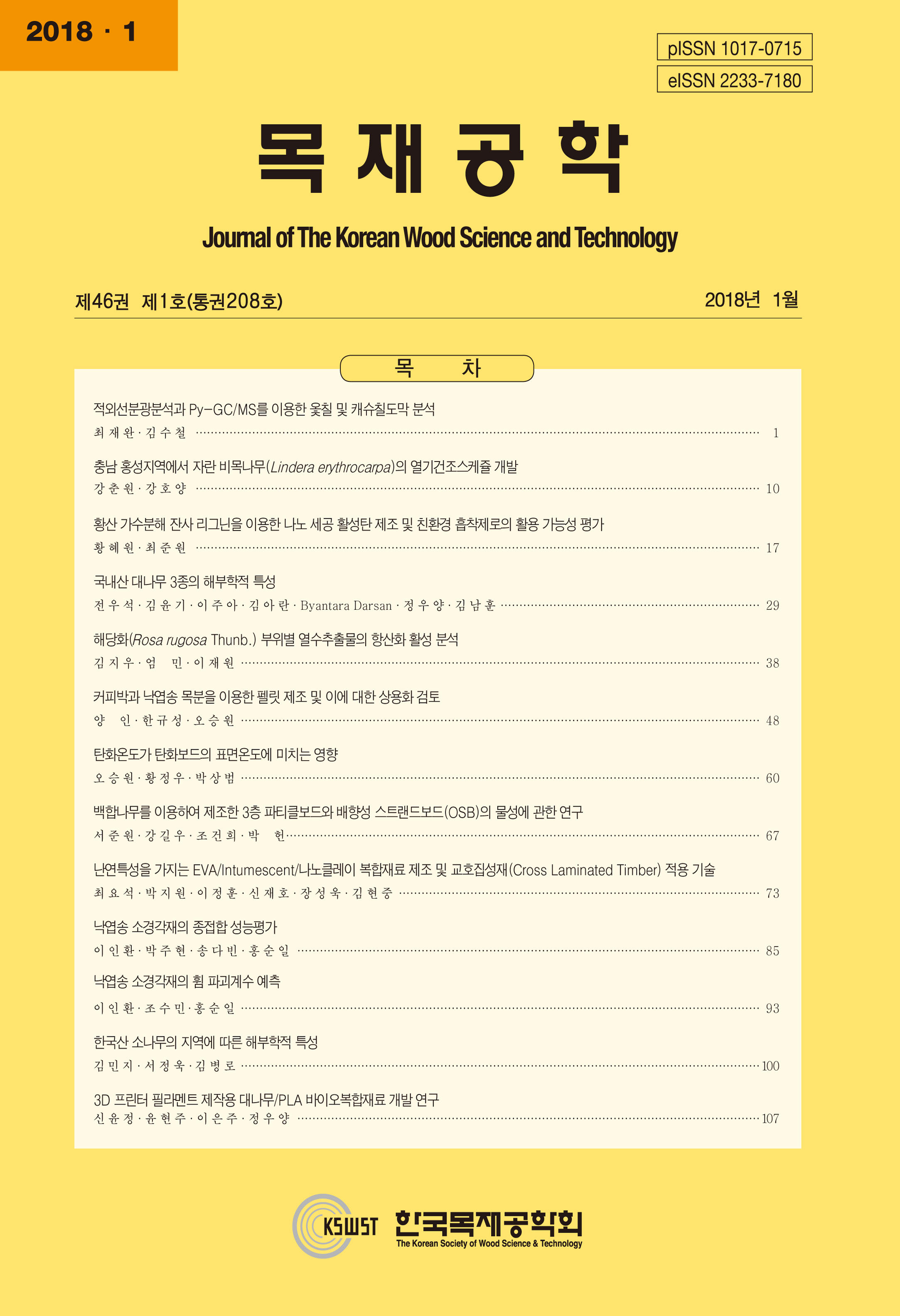본 연구는 커피 생산 폐기물인 커피박의 효율적인 처리 및 재자원화 방안의 일환으로 목분과 혼합하여 고체 바이오 연료인 펠릿을 제조하고자 수행하였다. 먼저 펠릿 제조에 사용된 커피박의 화학적 조성과 연료적 특성을 조사하여 커피박의 펠릿 원료화 가능성을 조사하였다. 또한 다양한 조건에서 낙엽송 목분과 함께 펠릿을 제조한 후, 최적 펠릿 제조조건을 제시하였다. 커피박은 전섬유소, 단백질, 지방/오일로 구성되었으며, 0.7% 정도의 회분을 함유하고 있었다. 회분에 대한 정성분석 결과, 칼슘, 나트륨, 칼륨, 마그네슘 순으로 조사되었다. 커피박의 용이한 건조 특성으로 인한 낮은 함수율과 높은 발열량 그리고 커피박/낙엽송 펠릿의 연료적 특성(함수율, 회분 함량, 겉보기밀도, 내구성)이 국립산림과학원에서 고시한 목재펠릿 품질기준의 1급을 상회하여 커피박의 펠릿 원료화 가능성을 확인할 수 있었다. 그러나 원소분석 결과, 커피박의 높은 질소 및 유황 함량으로 고등급의 펠릿 제조용 원료보다는 NOx 및 SOx를 효과적으로 제거할 수 있는 포집장치를 보유한 열병합발전소용 펠릿 원료로 적당할 것으로 생각한다. 그러나 커피박 및 낙엽송을 이용하여 1급 기준을 만족하는 펠릿을 제조하기 위하여 91 wt%의 낙엽송 목분과 9 wt%의 커피박이 필요할 것으로 추산된다. 이 조건에서 제조한 펠릿의 질소함량은 0.298% 그리고 유황 함량은 0.03%로 1급 기준을 만족하며 나머지 펠릿의 품질 항목에서도 모두 1급 기준을 상회할 것으로 예상된다. 마지막으로 커피박과 낙엽송의 구매가 및 각 등급의 목재펠릿 수요에 따라 펠릿 내의 커피박과 낙엽송 목분 양을 적절히 조절하여 펠릿을 제조할 경우, 생산비용의 절감 외에 폐기물의 이용에 따른 재자원화와 쓰레기 감량을 통한 환경부담 완화에도 일조할 것으로 생각한다.
This study was conducted to suggest the effective management and recycling processes of coffee waste, which can be easily obtained from coffee shops and coffee-related products industries. Prior to the fabrication of pellets, the potential of coffee waste as a raw material of pellet was investigated through the examination of its chemical compositions and fuel characteristics. Major gradient included in coffee waste was holocellulose, followed by fat/oil and protein. Coffee waste contained a small quantity of ash (0.7%), such as calcium, sodium, potassium and magnesium. Interestingly, coffee waste was easily dried probably due to its porous structure. Pellets fabricated with coffee waste and larch sawdust showed good fuel characteristics, such as moisture content, ash content, density and durability. The pellets exceed greatly the minimum requirements of 1st-grade wood pellet standard designated by National Institute of Forest Science (NIFOS). Particularly, the high calorific value of coffee waste showed the potential as a raw material of pellet. However, owing to high nitrogen and sulfur contents, coffee waste is like to be used as a raw material of wood pellet for combined heat and power plants equipped with a reduction system of NOx and SOx gases. On the other hand, 91 wt% larch sawdust and 9 wt% coffee waste are required to fabricate the 1st-grade wood pellets designated by NIFOS. Pellets fabricated with the conditions are estimated to have nitrogen content of 0.298% and sulfur content of 0.03%. Lastly, if amounts of coffee waste and sawdust in the production of wood pellets are adequately adjusted according to its purchasing price, the manufacturing cost of pellet can effectively be reduced. In addition, it is expected tp prepare the effective recycling process of waste and to relieve the environmental burden with the reduction of waste from the commercialization of coffee waste/larch pellets.


